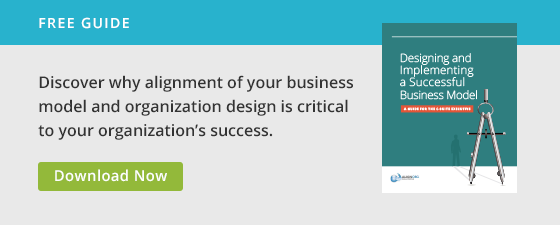I am often asked, “Why is having an aligned organization so important?” Those asking that question often are being pressed by a bottom-line focused executive to justify the time and cost associated with trying to perfectly align the organization. By definition, an aligned organization is one that optimally syncs the work, structure, metrics, people, rewards, culture, and leadership to strategy. It seems intuitive enough, but those who have spent any time trying to align or realign organizations realize that alignment work can be time-consuming and politically-charged, yet exhilarating and fulfilling.
So, what are the practical benefits of achieving organization alignment?
- Increased speed in decision making. Indecision can cripple productivity, cause missed deadlines, and create ripple effects across an organization. Organization alignment provides greater clarity around who holds the decision rights in the organization for each work activity. Aligned organizations result in quicker decisions and reduced time to execution. Organization alignment also allows employees to focus on performing work rather than on figuring out who is supposed to do what and who needs to be consulted when making decisions.
- Better employee engagement. Most employees want to enjoy their job, feel that their work is meaningful, and see that they are making a difference. An aligned organization connects and communicates an employee’s work to the organization’s strategy. When employees understand how their individual work links to company strategy, they are more satisfied with their work and become more effective.
- Less wasted resources. An aligned organization clearly differentiates between activities that promote growth and those that play more of a supporting role. This clear delineation ensures that the company focuses their limited resources on the right activities to promote growth and that they align functional and business priorities. Among many things, this helps companies do more with less, creating a reduction in cost while simultaneously increasing performance.
- Improved self-governance. One of the natural consequences of a well-aligned organization is that employees have a clear vision of their work, priorities, and especially their decisions. As a result of less ambiguity surrounding their responsibilities, instead of waiting to be told what to do or asking permission, employees have the confidence to make decisions on their own and control the issues within the scope of their role.
- Less customer confusion. Customers and external stakeholders want consistent achievement of expectations and deliverables. A truly aligned organization creates mechanisms that ensure that processes consistently deliver what is expected. In this way, the organization absorbs the complexities required to deliver seamless products and services to customers and can do so every time.
- Increased leadership credibility and respect. At the end of the day, actions and consistent delivery speak much louder than words or a perfect organization structure. As chief alignment officers, leaders that can regularly deliver on promises and expectations have the respect of employees. Alignment improves efficiency, delivery, and effectiveness and inherently improves employees’ respect for leaders as well.
- Greater resource visibility. In an unaligned organization, resources are often hidden in shadow organizations. In a well aligned organization, however, every function delivers to a common strategy and there is less need or incentive to sandbag resources and head count or to create shadow organizations to meet an unfulfilled need. Thus, the organization knows what resources exist and can redeploy duplicate resources to strategic challenges. In the end, the organization has less waste, less unnecessary duplication, and more resources to improve the company performance and productivity.
- Optimize talents and skills. When work is understood, roles are defined, and other organizing choices are aligned to strategy, it is easier to see what talent is needed, where talent exists within the company, and how to deploy key individuals to maximize their skills. While the organization gets what and who it needs, employees also benefit as they fully utilize their talents and have a clear career paths. The result is a better organization, higher satisfaction, and improved productivity for employees.
- Safe risk taking. Although an oxymoron, a safe risk is essentially one that has known or anticipated outcomes despite the potential risk. In aligned organizations, you can better anticipate the outcomes of changes or risks whereas in unaligned organizations a set of choices in one part of the organization often produces unexpected results overall. Organizations are perfectly designed to get the results they are getting. When leaders understand what their choices are designed to do, they can also anticipate what they won’t do. Thus, an aligned organization can lead to safe risk taking.
- A dynamic culture. The culture of an organization feeds off the choices made and the overall successes or failures of an organization. If the choices and energy is positive, focused, accountable, and winning, then the culture will quietly convey, disseminate, and reflect that message throughout the company. Positive cultures do not happen in isolation, and good choices help create good culture.
Unfortunately, it is difficult to achieve perfect organization alignment; however, the better aligned the organization the more you can realize the benefits above. Sure, alignment is an investment of time and money, but in today’s competitive marketplace it is hard to ignore the benefits of true organization alignment.
Editor’s note: This blog was originally published on June 1, 2016. It has since been updated.






